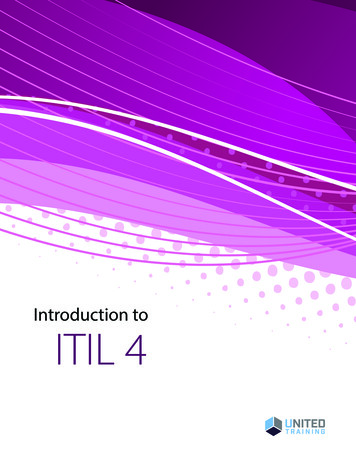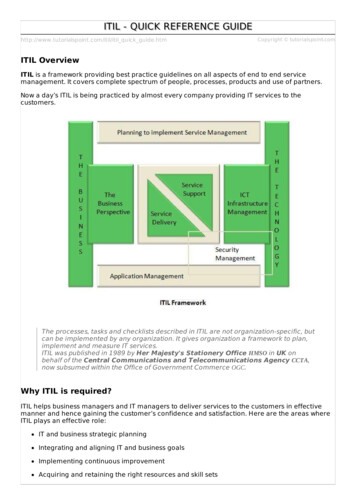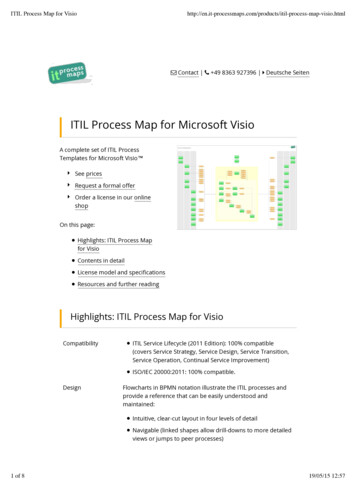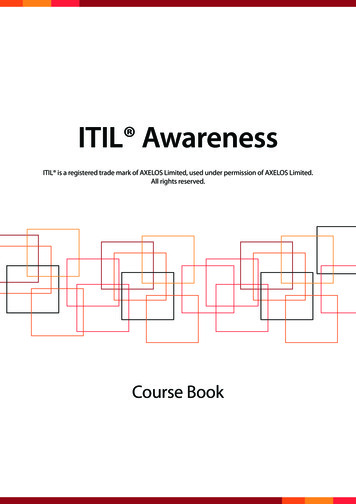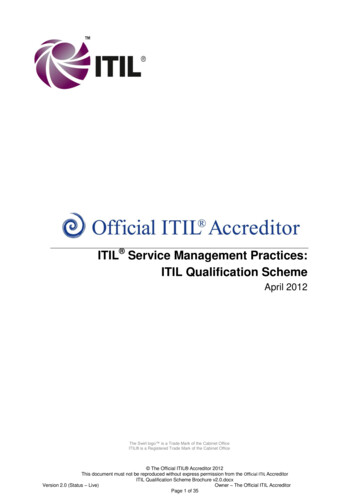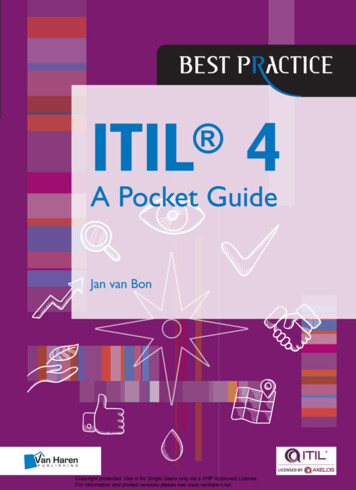
Transcription
Using the ITIL process reference model for realizing ITGovernance: An empirical investigationJon Iden, Norwegian School of Economics, Norway, jon.iden@nhh.noTom Roar Eikebrokk, University of Agder, NorwayFull reference: Iden, J. & Eikebrokk, T.R. (2014). Using the ITIL process reference model for realizing ITGovernance: An empirical investigation. Information Systems Management, 31(1), 37-58.AbstractITIL is a popular framework for IT governance, but little academic research on ITIL exists. We investigatethe overlap between ITIL and IT governance practices to illustrate ITIL’s potential to stimulate ITgovernance. A field study shows that IT implementation success is particularly influenced by groupefficacy and organizational resources, and to a lesser extent senior management involvement. Findingsshow that ITIL, as expected, is a framework that contributes to IT governance by stimulating processmanagement practices.Keywords: Information Technology Infrastructure; IT Service Management; ITIL; ITSM; IT Governance;online survey1 IntroductionIT governance is defined as leadership and structures, processes, and relationships that ensure thatthe organization’s IT sustains and extends its strategy and objectives (De Haes & Van Grembergen,2009), and has been the focus of substantial attention from both academics and practitioners. Studieshave found that IT governance positively affects IT performance (Weil & Ross, 2004). Companies haveinvested heavily in reference models and industry standards––such as COBIT, Prince2, ISO 9001, ISO/IEC 20000, and Val IT (Van Grembergen & DeHaes, 2008)––in order to achieve IT governance, and thistrend is expected to continue (Buckby, Best, & Stewart, 2009). Whether firms can achieve ITgovernance by implementing such models and standards is an important question. Little evidenceexists on their effects on IT governance. One reference model that has recently received particularattention from practitioners is ITIL. Despite its popularity, surprisingly few studies have investigatedhow ITIL as a framework can contribute to IT governance. Two questions seem especially relevant:does ITIL improve IT governance through better process management, and why do so many companiesstrive to implement ITIL?Four considerations motivate our focus on ITIL and these questions. First, there is still little academicresearch available around reference models and industry standards for IT governance (VanGrembergen, 2009). This constitutes a gap in IT governance research. The prevalent global popularityof ITIL opens a challenging research opportunity, and more research on ITIL is called for (Conger,Winniford, & Erickson-Harris, 2008; McBride, 2009). Second, literature argues that ITIL supports ITgovernance (Ko & Fink, 2010; Selig, 2008), but a detailed assessment of this argument has not beenIden & Eikebrokk: Using the ITIL process reference model for realizing IT Governance. ISM, 31(1), 37-58
performed. Additionally, because of its focus on processes, ITIL implementation should theoreticallyplay a significant role in increasing process management practices in the IT function, and thus stimulateIT governance. This relationship has not yet been subjected to investigation and empirical testing.Third, reports indicate that implementing ITIL is not straightforward, and research has found ITILimplementation to be a challenging undertaking (Cater-Steel & Pollard, 2008; Cater-Steel & Toleman,2010; Iden, 2009; Pollard, Gupta, & Satzinger, 2010). Researchers have found that a number of factorsare vital for implementation success (Iden & Langeland, 2010). However, these findings needtheoretical validation. Fourth, literature suggests that the ITIL implementation progress depends onthe environmental conditions, such as sector and business condition. For example, research hasreported that large government organizations with a large IT workforce are the most advanced (CaterSteel, Tan, & Toleman, 2009). However, such potential variations in the impact of ITIL implementationneed to be empirically tested.This field study focuses on ITIL implementation in the Nordic countries (Sweden, Denmark, Norway,and Finland). The reason for focusing on this region is that, to date, most of the empirical studies onITIL are limited to Australia and the U.S. This calls for more research in other international settings. Thefour Nordic countries constitute an interesting opportunity, as Nordic companies have been especiallyactive in adapting to ITIL and engaging with the IT Service Management Forum (itSMF). Although theircombined population is less than twenty-five million, the four Nordic countries constitute about fifteenper cent of the total number of itSMF members internationally. We conduct a survey research becauseresearch on ITIL is dominated by case studies, and there is a need for more theory-based research inthis area.This paper addresses the gap in knowledge noted above. Our study contributes to the literature in twodifferent ways. First, our study offers novel insight into how ITIL is positioned in relation to ITgovernance. Our investigation shows that ITIL offers solutions for a variety of the IT governancepractices (De Haes & Van Grembergen, 2009), especially those categorized as processes. Second, thiswork demonstrates the relative importance of key organizational factors that enable ITILimplementation, as well as ITIL’s consequences for the process management practices in the ITfunction. IT managers may address these findings when preparing and evaluating their ITIL initiatives.This article proceeds as follows. First, we account for our theoretical basis. We derive and discusshypotheses concerning the antecedents and process management consequences of ITILimplementation. Then, we describe a large field study undertaken to test our hypotheses, and presentthe results. The paper concludes by discussing key findings, implications for practice and futureresearch, and limitations.2 Theoretical basis2.1 IT governanceIT governance focuses on the direction and control of IT, and can be deployed using a mixture ofvarious structures, processes, and relational mechanisms situated at multiple layers in the organization(De Haes & Van Grembergen, 2009; Van Grembergen, De Haes, & Guldentops, 2003). A growingnumber of reference models and industry standards address IT governance (Buckby, et al., 2009).However, a comprehensive framework that covers and integrates all the practices necessary to plan,develop, and deploy a comprehensive IT governance approach in a firm does not exist (Gottschalk,Iden & Eikebrokk: Using the ITIL process reference model for realizing IT Governance. ISM, 31(1), 37-58
2006). Therefore, implementing IT governance means a firm must select the best or most suitable ofall of the models and standards available, develop a blend of the best attributes of each of theframeworks, and tailor an approach that is realistic and sustainable (Selig, 2008). A company may, forexample, use COBIT for IT audit and control, ISO 17799 for security management requirements,PRINCE2 for IT projects, the Balanced Scorecard for visions and strategies, and Val IT for IT investments.2.2 IT governance practices and ITILAs a reference model for IT governance, ITIL emphasizes the control of IT through processes (Taylor,2007), and is strongly influenced by quality management and process reengineering (Galup, Quan,Dattero, & Conger, 2007). ITIL focuses on the flow of activities that cross organizational units, bothinside and beyond the IT function. The objective is to maximize IT’s ability to provide services that arecost effective and meet the needs and expectations of the business as manifested in the Service LevelAgreement. Having grown from a collection of recommended IT processes, the latest version (3)focuses additionally on strategy, markets, capabilities, control, and governance (Taylor, 2007). ITILcovers more than operations, and aligns with the ISO standard ISO/IEC 20000.ITIL is frequently presented as an enabler for IT governance (Ko & Fink, 2010; Selig, 2008; VanGrembergen & DeHaes, 2008). However, we have not been able to identify literature that analyses andassesses how ITIL enables IT governance practices. Based on an analysis and comparison of thecomplete ITIL version 3 volumes with De Haes and van Grembergen’s validated list of IT governancepractices (De Haes & Van Grembergen, 2009), we present an overview of how ITIL may serve as aframework for IT governance in Table 1. In the table, “index” refers to the structures (S1–S12),processes (P1–P11) and relational mechanisms (R1–R10) that are included in the IT governancereference literature.Table 1: IT governance practices and corresponding ITIL practicesIndexIT governance practiceCorresponding ITIL areaCorresponding ITIL practiceS1S4S5S6IT strategy committee at level ofboard of directorsIT expertise at level of boarddirectors(IT) audit committee at level ofboard of directorsCIO on executive committeeCIO reporting to CEO and /or COOIT steering committeeService designS7S8IT governance function / officerSecurity / compliance / risk officerIT steering groupIT designer / architectIT managementSecurity managerIT service continuity managerS9IT project steering committeeS10S11S12IT security steering committeeArchitecture steering committeeIntegration of governance/alignment tasks in roles &responsibilitiesS2S3Service strategyInformation security managementIT service continuity managementRisk managementCrisis managementRelease and deploymentmanagementChange managementInformation security managementService designBusiness relationship managementChange advisory boardInformation security managerSystem managementBusiness relationship managerIden & Eikebrokk: Using the ITIL process reference model for realizing IT Governance. ISM, 31(1), 37-58
P1Strategic information systemsplanningP2IT performance measurementP3Portfolio managementService lifecycle managementBusiness service managementService portfolio managementDemand managementContinual service improvementService level managementPerformance managementService capacity managementService portfolio managementP4P5Charge back arrangements (TCO)Service level agreementsFinancial managementService level managementP6P7IT governance framework COBITIT governance assurance and selfassessmentProject governance / managementmethodologiesIT budget control and reportingBenefits management andreportingContinual service improvementContinual service improvementP8P9P10P11R1R2R3R4R5COSO / ERMJob rotationCo-locationCross-trainingKnowledge managementBusiness / IT account managementR6Executive / senior managementgiving the good exampleInformal meetings betweenbusiness and IT executiveIT leadershipCorporate internal communicationaddressing IT on a regular basisIT governance awarenesscampaignR7R8R9R10Continual service improvementService transitionService strategyRelease and deploymentmanagementEvaluationContinual Service ImprovementService improvement planService portfolioBalanced scorecardService measurement andreportingService level achievementsService portfolioApplication portfolioAsset managementCharging / chargebackService level agreementsService catalogue managerService level managerCOBITISO / IEC 20000AuditPMI and Prince2Release managementFinancial managementReviewPost implementation reviewEvaluation reportThe 7-step improvement processKnowledge managementBusiness relationship managementKnowledge managementBusiness relationship managerAccount managerService strategyIT managementTable 1 provides new insight into how ITIL is positioned in relation to IT governance. ITIL offerscorresponding practices for as many as twenty of the thirty-three IT governance practices (De Haes &Van Grembergen, 2009). It is especially notable that ITIL facilitates all of the IT governance practicescategorized as processes (P1–P11). Table 1 supports the proposition that by successfully implementingITIL, companies can improve their process management activities and IT governance. However, ITIL isnot inclusive when it comes to structural and relational practices. Here, firms must look to otherreference models and industry standards.Most organizations planning to implement ITIL will already have a set of existing practices established.ITIL implementation requires a four-step approach: 1) identifying the company’s existing practices, 2)achieving competence in ITIL recommendations, 3) redesigning existing practices based on ITILrecommendations, and 4) realizing the outcomes and instigating process management. Most firmschoose a single-process approach when implementing ITIL by prioritizing the user-centric areas like theservice desk and incident management. From there, firms gradually continue with processes likeservice level management, change management, and problem management (Cater-Steel, et al., 2009;Iden & Eikebrokk: Using the ITIL process reference model for realizing IT Governance. ISM, 31(1), 37-58
Iden, 2010). The level of ITIL implementation increases in a company as more of the ITIL processes aredeployed, and as the processes mature (Van Grembergen & DeHaes, 2008).2.3 Prior researchOne research question that has challenged researchers is what factors have the greatest impact onsuccessful ITIL implementation. We used a literature review to identify important factors for success.These factors are presented in Table 2.Table 2: Review of factors influencing ITIL implementation identified by prior researchHochstein et al.,2005Cater-Steel et al.,2005Tan, Cater-Steel &Toleman, 2009Iden, 2009Pollard & CaterSteel, 2009Iden & Langeland,2010Support frommanagementCommitment fromseniormanagementSeniormanagementsupportNeed forimprovementstrongly recognizedTop managementsupportManagement musthave ownershipBroad-based stafftrainingA champion toadvocate andpromote ITILProject championOpenness aboutpurpose, plans, andresultsTraining and staffawarenessContinuity inprojectorganizationDemonstratebenefits through“quick wins”Ability of IT staff toadopt to changeRelationships withvendorsTraining andexpertiseQuality of staffallocated to ITILChange incorporate cultureBroad participationInterdepartmentalcommunicationand collaborationITIL-friendly cultureSeniormanagement mustdecide toimplement ITILIdentify and involvekey personnelInternalcommunicationand marketingStrive forcontinuousimprovementDevelop newprocess while inoperationITIL training for ITstaffProject governanceand executionA methodology forprocess changeProcess as apriorityRealization ofbenefitsDeliverablesproduced at groupmeetings onlyShort timelineCustomer-focusedmetricsUse of consultantsTiming and carefulselection of anITSM toolsetSeniormanagement musthave knowledgeabout processorientationStart with a few ITILprocessesInformation topersonnel andcustomersProvidecompetence inprocess thinking,and ITILA modular ITSMsystem is neededThe research and the factors identified in Table 2 are based on different research methods, mainlydescriptive studies. In general, questions regarding determinants for success were only one amongseveral research themes in these studies. Therefore, it may be difficult to compare the results.However, our review points to existing theories and antecedents to implement strategic IT initiatives(Basu, Hartono, Lederer, & Sethi, 2002; Cerpa & Verner, 1998; Earl, 1993; Gottschalk, 1999): seniormanagement involvement, organizational commitment, and group efficacy. These antecedents arediscussed in the next section.3 Antecedents and consequences3.1 Antecedents to ITIL implementationThe first antecedent pertains to IT senior management. The key role of senior management inorganization development success in general has been highlighted by many researchers (Dong, 2008;Iden & Eikebrokk: Using the ITIL process reference model for realizing IT Governance. ISM, 31(1), 37-58
Woolridge, Schmid, & Floyd, 2008). McDonough (2000) suggests that top managers help projects by avariety of means, such as demonstrating commitment, helping the team to surmount obstacles,making things happen and providing encouragement to the team. Similarly, Emmanuelides (1993)proposes that development projects depend heavily on top management for acquisition of necessaryresources, approval of design proposals, securing of required legitimacy, and delegation of necessarydecision-making authority. Within ITIL, senior management involvement means that top executivescommit themselves to providing strong support for the project from its initiation to its end (Cater-Steel& Tan, 2005b; Hochstein, Tamm, & Brenner, 2005; Pollard & Cater-Steel, 2009). Top management mustprovide feedback and guidance throughout the implementation (Hochstein, et al., 2005). However, asidentified Cater-Steel and Tan (2005b) and Tan, Cater-Steel, and Toleman (2009) it is essential that oneperson from the executive committee champions and advocates ITIL. This leads us to our firsthypothesis:H1: As senior management involvement in the ITIL project increases, so does the level of ITILimplementation.The second antecedent relates to how the organization and its members commit themselves to theeffort. Organizational commitment has been repeatedly identified as an important variable inunderstanding the behavior of employees in organizations (Mowday, Steers, & Porter, 1979). Althoughcharacterizations of organizational commitment vary, definitions tend to focus on employee behavior(Salancik, 1977; Staw, 1977) and attitude (Sheldon, 1971). High commitment presents itself in a strongbelief in and acceptance of the firm’s goals and values, and a willingness to exert considerable effortin reaching them. Within ITIL, commitment is indicated by the presence of sufficient resources (Tan, etal., 2009), involving key people in process design, and letting them stay on the implementation effortfrom start to finish in order to maintain continuity (Iden & Langeland, 2010). It is important forparticipants to recognize the need for improvement so that they try their hardest to implement ITIL(Iden, 2009). From this we can postulate:H2: As organizational commitment to the ITIL project increases, so does the level of ITILimplementation.The third antecedent relates to the characteristics of the ITIL project and the team’s belief in its abilityto perform effectively (Gibson, 1999). High efficacy perception enhances task performance (Sadri &Robertson, 1993). Through observational and self-reporting techniques, researchers have establishedthat group efficacy is a meaningful and measurable group attribute and that levels of group efficacyvary among groups (Gibson, 1999). The level of group efficacy is often related to how much effort thegroup exerts, and researchers have found efficacy to be a determinant of group effectiveness (Gibson,1999). This follows logically from social cognitive research regarding individual work behavior, whichhas demonstrated that the higher the level of self-efficacy, the better an individual performs (Bandura,1997). With respect to ITIL implementation, group efficacy means that project members aresufficiently trained and that they possess sufficient knowledge about ITIL and process thinking (CaterSteel & Tan, 2005b; Hochstein, et al., 2005; Iden & Langeland, 2010). It also means that they have theskills necessary to identify, analyze, and design processes by utilizing ITIL recommendations, and thatthey have a well-defined method for process development (Iden, 2009). Therefore, we can expect that:H3: As group efficacy in the ITIL project increases, so does the level of ITIL implementation.Iden & Eikebrokk: Using the ITIL process reference model for realizing IT Governance. ISM, 31(1), 37-58
The fourth antecedent relates to the characteristics of the organization. We expect that sources of ITILimplementation success are also embedded in the resources and capabilities of the firm. In theresource-based view of the firm, competitive advantage is achieved through assembling andorchestrating difficult-to-copy resources, defined as a bundle of assets, capabilities, organizationalprocess, firms attributes, information, and knowledge (Teece, Pisano, & Shuen, 1997). ITILimplementations with greater resources have more surplus power and therefore more latitude forprogress and outcome. Based on this view, we anticipate that budget (the amount of economicresources made available for the ITIL effort), size (the number of staff and IT employees), and revenue(company income), will influence the firm’s ability to implement ITIL. We also expect that experiencewith ITIL, reflected by the years since the initiative was taken, will affect ITIL implementation. Fromthis we can expect that:H4: As the organizational resources increase, so does the level of ITIL implementation.3.2 Process management consequences of ITIL implementationIT governance and ITIL each place heavy emphasis on the importance of processes and processmanagement (Selig, 2008; Taylor, 2007; Van Grembergen & DeHaes, 2008). As we have discussedabove, process is one of the three types of practices in IT governance, and process management isespecially relevant for IT planning, project management, portfolio management, risk management, ITservice delivery and support, and performance management. Process management in IT governancemeans that processes are well defined, documented, and measured (Selig, 2008). It also impliesnominating process owners and assessing process maturity for improvement (Van Grembergen &DeHaes, 2008). For ITIL, as a process reference model, process management requires each process tobe controlled so that they remain compliant with the objectives of both IT and business (Taylor, Case,& Spalding, 2007a). The literature offers various models for process management (Becker, Krugeler, &Rosemann, 2007; Gulledge & Sommer, 2002; Hammer & Stanton, 1999; Küng & Hagen, 2007; Pritchard& Armistead, 1999; van der Aalst, ter Hofstede, & Weske, 2003). For our investigations and analysis,we have, based on existing models, divided process management into seven distinctive but relatedpractices: process standardization, process documentation, process ownership, process goals, processmonitoring, process improvement, and process certification. Each of these is discussed below. Webelieve that as the ITIL implementation level increases, so will the level of process management interms of the extent to which the seven process management practices are implemented.The first practice is the standardization of the way a certain process is executed. The objective is thatmatching cases are handled in the same way; cases should follow the same predefined workflow, andare subject to the same organizational procedures and rules every time they occur (Hammer &Stanton, 1999). Standardization leads to predictability, both for staff and customers, and is oftenviewed as the first step towards process management (Rosemann & de Bruin, 2005; Van Grembergen& DeHaes, 2008). Process standardization is a fundamental principle of ITIL: there is one best way tohandle a certain type of case, and this way should be followed by every function and every staffmember (Taylor, 2007). For example, in order to comply with the negotiated standards set in theservice level agreements, every request for change must follow the standardized change managementprocess (Taylor, Lacy, & MacFarlane, 2007b). Case studies have identified process standardization asone of the main implementation effects of ITIL (Hochstein, et al., 2005). Therefore, we can expect that:Iden & Eikebrokk: Using the ITIL process reference model for realizing IT Governance. ISM, 31(1), 37-58
H5: As the ITIL implementation level increases, so does the level of process standardization.Another practice of process management is that the characteristics of a process should be capturedand documented (Ungan, 2006). Process documents describe the process by its activities, workflow,roles, resources, rules, and outcomes (Harmon, 2003). The purpose is to provide employeescollectively with detailed information on how the process as a whole is executed, as well as the moredetailed characteristics relevant to each role. Process documentation is also the basis for furtherrefinement and improvement. ITIL consists of documented processes, and this is one of the attributesthat make ITIL a reference model. The recommended practice for each process is documentedaccording to a standard format, including process models. Likewise, implementing ITIL involvesdescribing the new practices in standard document templates, as recognized by case studies (CaterSteel, Toleman, & Tan, 2006b). Therefore, we can expect that:H6: As the ITIL implementation level increases, so does the level of process documentation.The establishment of process ownership is an additional practice (Harmon, 2003; Spanyi, 2006). Eachprocess should have a process owner who is responsible for process performance and outcome. Theprocess owner’s primary tasks are to oversee the implementation of a new design, to follow up on itsperformance and to coordinate with functional managers and other process owners. (Hammer &Stanton, 1999). ITIL emphasizes the role of the process owner, and portrays the role comparably tothe description above (Taylor, Lloyd, & Rudd, 2007c). Although the process owner is a novel role formany IT functions, organizations implementing ITIL have found it effective to appoint them (CaterSteel, 2009; Tan, et al., 2009). This leads to the following hypothesis:H7: As the ITIL implementation level increases, so does the level of process ownership.Establishing explicit goals for process performance is a central practice. The process literatureidentifies a variety of relevant goals (Davenport & Beers, 1995; Garretson & Harmon, 2005; Kueng,2000). Harrington (1991), for example, suggests goals for effectiveness, efficiency, and adaptability,but the literature offers alternative approaches (Kueng, 2000). ITIL includes the process goal in itsdefinition of process (Berkhout, Harrow, Johnson, Lacy, Lloyd, Page, van Goethem, & van den Bent,2000). According to ITIL, all processes should have explicit goals (Taylor, et al., 2007a). This leads to thefollowing hypothesis:H8: As the ITIL implementation level increases, so does the level of explicit process goals.Monitoring is another process management practice (Harmon, 2003; Smith & Fingar, 2003). Processgoals must be translated into performance indicators that can be monitored. Firms must continuouslyassess process performance and verify that goals are met (Hammer, 2007). ITIL mandates thatprocesses be monitored in order to ensure that they comply with requirements (Taylor, et al., 2007a).Case studies confirm that such monitoring practices have been adopted by firms implementing ITIL(Cater-Steel, et al., 2006b). This leads to the following hypothesis:H9: As the ITIL implementation level increases, so does the level of process monitoring.Processes should be improved when monitoring reveals that they are not meeting the requirementsset, or when new requirements arise (Harmon, 2003; Smith & Fingar, 2003). Improvement effortsIden & Eikebrokk: Using the ITIL process reference model for realizing IT Governance. ISM, 31(1), 37-58
should be based on factual information. They can be minor adjustments to the existing layout, or cantake the form of a large project if a major revision or a totally new design is required (Hammer &Stanton, 1999). Improvement is central in ITIL, and one set of standards is dedicated to continualimprovement (Taylor, et al., 2007a). The main message is that once implemented, the ITIL processesshould constantly be evaluated and improved in order to fulfill changing business needs. This leads tothe following hypothesis:H10: As the ITIL implementation level increases, so does the level of process improvement.The last practice of process management included in this study is that the system of processes iscertified according to an international standard. We acknowledge that this criterion is beyond mostdefinitions of process management; however, several forces provide a strong impetus for firms toinvest in process certification. International institutions such as ISO—International Organization forStandardization––argue that process certification is necessary in order to fulfill customer expectationsand requirements for product and service quality (ISO, 2000). A certification gives evidence thatprocesses are documented and that accountability has been defined, and is a strong indication thatthe firm has started to analyze processes and initiate change programs (Harmon, 2003). Two standardsare especially applicable in accordance with ITIL: the general ISO 9000 quality standard and the areaspecific standard ISO/IEC 20000 for IT service management. Research finds that there is an growinginterest among ITIL firms in these standards (Cater-Steel, et al., 2009). This leads to the followinghypothesis:H11: As the ITIL implementation level increases, so does the level of process certification.Figure 1 sums up the hypothesized relationships between antecedents to and consequences of ITILimplementation.Figure 1: Hypothesized relationships involving antecedents and consequences of ITIL implementation4 Research methods4.1 Data collectionTo test the hypotheses, an anonymous online survey was initiated in Finland, Sweden, Denmark, andNorway. The questionnaire was pretested on five respondents and wording was adjusted prior to thesurvey. The survey was conducted in English. The targeted sample was drawn from the members ofthe Nordic itSMF chapters who were using ITIL, resulting in a total of 5,943 active e-mail addresses.See Appendix 1 for the survey instrument.Iden & Eikebrokk: Using the ITIL process reference model for realizing IT Governance. ISM, 31(1), 37-58
4.2 Operationalization and measurementThe indicators of each of the elements of ITIL antecedents and consequences are described below.Senior management involveme
Iden, J. & Eikebrokk, T.R. (2014). Using the ITIL process reference model for realizing IT Governance: An empirical investigation. Information Systems Management, 31(1), 37-58. Abstract. ITIL is a popular framework for IT governance , but little academic research on ITIL exists. W e investigate




